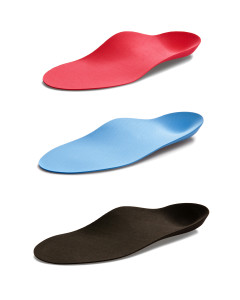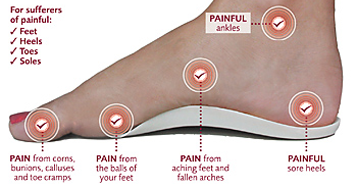Thursday, March 20th 2014 AT 8:29 am Osteopath - Sports Injury specialist
Musculoskeletal and other disorders of human function are frequent, distressing, debilitating and are related to dysfunction of the lower extremity. Increasing numbers of people are suffering from non-traumatic disorders of the musculoskeletal system which are not readily diagnosed or effectively treated by conventionally trained health professionals.
The diagnostic methods (physical examination of the site of the pain, lab tests and imaging techniques) used to identify structural disease or deformity are largely unhelpful in defining these disorders. Therapies such as rest, drugs, injections and surgery are mostly ineffective or provide only temporary relief of symptoms. These problems tend to be chronic and recurrent and frequently result in degeneration or deformity in isolated joints and other tissues. The lack of understanding of the pathophysiology of these common conditions causes them to be labeled as “overuse” or other “syndromes”, thus hiding the inability of current medical paradigms to comprehend them.
Why Do People Have These Problems? New Paradigm: “The human foot was originally designed to travel on soft, natural surfaces like earth and sand. Unfortunately, we now spend every day walking and standing on unnatural hard, flat surfaces like pavements and floors. The problem of walking on hard surfaces such as pavements may alter the biomechanics of walking. This may lead to potential arthritic changes and consequently a reduction in foot function, pain and disability.” – Professor Keith Rome, Professor of Podiatry, Faculty of Health and Environmental Sciences, AUT University.
The structural/traumatic medical paradigm does not contribute to understanding these problems because they are due to normal anatomy, which is functioning abnormally. The source of these problems lies outside of the body and not within. These disorders are related to the environment in which out bodies function. Our anatomical structures evolved over millennia to function efficiently in a primitive natural world. For most of our evolutionary history we existed in nature as nomadic hunter-gatherers for whom the integrity and efficiency of the musculoskeletal system was essential to survival.
The 300 homeobox genes that determine the segmental structure of the human body are unchanged since the time of Homo Erectus 1.8 Million years ago. Our current species, Homo Sapiens, has successfully inhabited the earth for 195,000 years. The development of agriculture and the domestication of animals began about 10,000 years ago but people still walked, ran and moved about on natural walking surfaces.
The invention of machines and the beginning of the Industrial Revolution about 200 years ago led to urbanization and a radical change in the environment under the human foot. The irregular, variable textures and inclinations of natural walking surfaces began to be replaced by flat level paved ones. Is it a coincidence that people also began to regularly wear modern types of shoes and complain of aching feet around the same time?
Our modern environment and lifestyle are drastically different and are bad for our health. Now that we are in the Information Age, living and working daily in an environment that is totally different from that in which we are so well evolved to function. This unfamiliar environment has undesirable effects on human health. Natural surfaces accept the shape of the human foot and allow the body to align itself and function in a stress-free way. They also stimulate the neuro-receptors in the sole of the foot with total contact and a wide variety of inputs. Modern walking surfaces force the foot into an adaptive posture, which we call excessive Pronation of the Subtalar Joint (STJ), that induces misalignment in the entire musculoskeletal system. They also produce excessive loading on small areas of the foot and inadequate stimulation and variety of sensory inputs, (perturbations) when compared to natural surfaces. We are victims of our own genetic success. We have altered our environment to induce injurious loading and adaptive stresses that cannot be indefinitely attenuated or compensated.
Mechanical Effects: The STJ pronates to the end of its range of motion. The leg internally rotates. The knee is misaligned and the patella mal-tracks. The hip anteverts. The pelvis anteverts and tilts. The spine and higher structures are all malaligned. The sole of the foot shows signs of overloading in specific locations, e.g. Corns, calluses, hallux valgus etc). Misalignment induces stressful forces in tissues stimulating the release of chemical pain mediators. Muscles and their associated attachments are overloaded by attempting to compensate for these mechanical misalignments and eventually malfunction. Oblique force vectors acting on joints lead to ligamentous stress, degeneration, susceptibility to failure and eventual osteoarthritis. Gait is dysfunctional and its sequence and determinants become inefficient, further overloading all lower extremity structures from T5 to the sole of the foot. Mobility and independence are impaired. The total posture of the body, (which has adverse effects upon internal organs as well as the musculoskeletal system) is liable to be abnormal.
Neuro-Motor Effects: Unnatural stimulation of the foot and misalignment in the body results in inappropriate stimulation of mechanoreceptors with disordered proprioception, balance and postural stability. Muscle imbalances, (abnormal weakness or tightness) develop because of incorrect posture and dysfunctional myotatic reflexes related to compensating for misaligned forces in the body. Studies are increasingly showing the potential for foot orthoses to change the EMG activity of muscles, even those in the hip and back. Dysfunctional motor patterns evolve in response to the abnormal neural input from mechanoreceptors in the foot and other structures. These patterns are attempting to compensate for the abnormal environment but do so at the expense of efficient locomotion. Muscles are overloaded and fatigue from attempting to attenuate abnormal impact vibrations, (Nigg, et al.)
Cardiovascular Effects: Inadequate compression of the venous plexus in the foot fails to activate the venous foot pump and initiate the flow of blood to the heart during midstance. Failure of the venous foot pump impairs the efficiency of the contraction of the leg muscles during propulsion to return blood up the leg. The venous plexus is not effectively emptied resulting in increasing resistance to the inflow of arterial blood in the capillaries. There is venous congestion and poor arterial blood flow in the foot leading to swelling, oedema, reduced tissue oxygenation, degeneration and ulceration. This is especially relevant in diabetics. Reduced cardiac return causes reduced stroke volume and cardiac inefficiency. A chain of adverse events begins. Lower extremity dysfunction leads to musculoskeletal discomfort, (aches and pains that are often ignored) which results in reduced physical activity, decreasing physical resilience. Later we develop various disabilities, degeneration, disease and finally premature death, (from causes that are often thought to be totally unrelated to musculoskeletal function.
How Should We Address These Problems? To solve problems we must understand their cause. Our modern epidemic of musculoskeletal disorder is related to our environment and not weakness or deformity of our anatomical structures. We must start to realise that people of all ages are affected and should be screened for lower extremity dysfunction even in the absence of symptoms.
How Far Can We Go With This Philosophy? Human life is essentially walking, eating, sleeping and reproduction. Many people still find it difficult to accept the efficacy of foot orthoses for relieving pain in the leg and knee, (even though there is strong scientific support for this). Many medical therapists struggle to understand the paradigm of dysfunction (as opposed to structural abnormality) as a cause of pain and disability even though this is the basis for rehabilitation and is extensively proven and documented. Accepting the relationship between the modern environment and dysfunction of the entire lower extremity is disputed even by many skilled Podiatrists who were taught that orthotics are correcting deformity of the foot and leg, (even when they see these “deformities” in over 80% of otherwise normal healthy people). The interrelation between the function of the foot and dysfunction of core structures, (weak stabilisers and external rotators) confounds many excellent rehabilitation therapists in spite of evidence that foot orthoses alter the EMG function of some of these muscles. Recent research has shown that orthotics have an immediate and long-term beneficial effect on balance, (improved after six weeks even when not standing on the orthotics) but most people are unaware of this neuro-motor effect. There are many anecdotal reports of people having had their back pain, shoulder pain, neck pain and even headaches relieved by foot orthoses, (in conjunction with other therapies) but research has yet to address these possibilities. We may discover more connections between foot function, lower extremity function, the health of the musculoskeletal system and through better mobility, enjoyment of living or unappreciated neuro-hormonal axes the healthy function of other organ systems and even mental well-being in the future.
Treatment: Foot Pain, Ankle Pain, Calf Pain, Plantar Fascitis, Heel Pain, Bunions, Iliotibial Band Syndrome, Chondromalcia Patello-Femoral Syndrome, Knee Pain, Sacroiliac joint dysfunction, Low Back Pain, Flat Feet, Pes Planus, Pes Cavus, Harrow Orthotics, Chelsea Orthotics, Wembley Orthotics. Orthotic Treatment At Chelsea Osteopaths, Harrow Osteopaths, Wembley Osteopaths by The Sports Injuries Specialist – Registered Osteopath. Regulated: Chelsea Orthotics, Harrow Orthotics, Wembley Orthotics – The Sports Injuries Specialist – Registered Osteopath. How Foot Pain – Ankle Pain – Calf Pain – Plantar Fascitis – Heel Pain – Bunions – Iliotibial Band Syndrome – Chondromalcia Patello-Femoral Syndrome – Knee Pain – Sacroiliac joint dysfunction – Low Back Pain – Flat Feet – Pes Planus – Pes Cavus is treated at Harrow Osteopaths, Wembley Osteopaths, Chelsea Osteopaths by The Sports Injuries Specialist – Registered Osteopath.
If you are in Extreme Pain and require orthotics, then call the Sports Injuries Specialist – Registered Osteopath – Chelsea Orthotics, Harrow Orthotics, Wembley Orthotics, for proven results immediately:

Zahir Chaudhary, BA (Hons), BSc (Hons), ND, M Ost.Med
Email: emergencyosteopath@gmail.com
Call: ![]() 0208 423 6209;
0208 423 6209; ![]() 0792 100 4705
0792 100 4705
Web: https://www.sportsinjuriesspecialist.co.uk
Chelsea Osteopaths, 208 Fulham Road, Chelsea, London. SW10 9PJ.
Harrow Osteopathic Clinic, 9 Littleton Road, Harrow, Middlesex. HA1 3SY.
Wembley Osteopaths, 31 Norval Road, Wembley. HA0 3TD.
David Lloyd Sudbury Hill Osteopaths, Greenford Road, Ealing. UB6 0HX.
Fitness First Osteopaths, 197 Ealing Road, The Atlip Centre, Alperton, Wembley. HA0 4LW.
LAST UPDATED ON January 9, 2016 AT 7:52 pm

